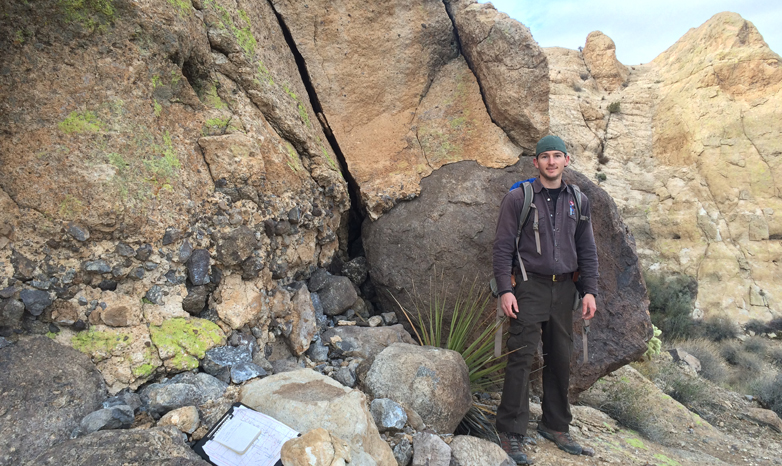NSF digs SRU geology major’s research

Blake Wallrich, a geology major from Pittsburgh, is one of only 10 students in the nation selected to participate in the Vanderbilt University Supereruption Research Experience for Undergraduates. Wallrich, a junior, is researching volcano deposits in Arizona's Southern Black Mountains.
Feb. 10, 2016
SLIPPERY ROCK, Pa. - Millions of years ago, one of earth's most explosive events - a "supereruption" - ejected tons of volcanic materials skyward from a vent located in the southern end of the Black Mountains of Arizona. The blast was thousands of times more powerful than the 1980 eruption of Mount Saint Helens.
While a casual observer today might just see a barren landscape, Slippery Rock University geology major Blake Wallrich and the National Science Foundation see a lithified volcanic ash deposit as a clue to understanding and possibly predicting future events where geological activity suggests a threat.
Wallrich's prior research at SRU of magma emplacement within the earth's crust and an application essay earned him a place among 10 undergraduates in the nation selected to participate in the Vanderbilt University Supereruption Research Experience for Undergraduates. The program, funded by the National Science Foundation, provides opportunities for students and faculty advisers to pursue field research.
Wallrich said he would be investigating deposits in the southern Black Mountain volcanic zone this summer. During the 2016 winter session, he traveled to the Black Mountains in western Arizona, the source location of the Peach Spring Tuff.
"This initial introduction to the Peach Spring Tuff field site allowed REU participants to examine extrusive volcanic deposits and begin constructing research projects that will give greater insight into supereruption events and how magma chamber processes can influence these eruptions," he said.
This coming summer, Wallrich will work with other volcanologists to conduct a study of the pumice fragments within the Sitgreaves Tuff, a previously unstudied unit within the Black Mountains. Analysis of pumice could shed light on the magma chamber processes that were contributing to the eruption.
"We will be investigating the composition of the pumice. Geochemical data from the pumice, along with the zoning within the crystals it contains, can be used to model conditions within the magma chamber that contributed to the eruption," he said.
Wallrich was chosen for the REU after completing a questionnaire and essay discussing how participating in the Supereruption REU would enhance his career goals
At 26, SRU classifies Wallrich as a non-traditional student. He spent five years working with various fire agencies out west after completing a Fire Science Certificate at Miramar College in San Diego, California.
After marrying in 2012, Wallrich began a two-year phase out from his engine crew leader position with the Bureau of Land Management-West Desert District in Utah, so that he could enroll at SRU, to "work smarter, not harder."
"Turns out I work just as hard here at SRU just in a different capacity, one that I thoroughly enjoy," he said.
Wallrich said he always liked the outdoors, having grown up in San Diego, California, surfing, hiking and camping almost every weekend. He worked for the U.S. Fish and Wildlife's Wildland Fire Engine 2438 during the 2013-2014 fire season. He moved to Salt Lake City, Utah, and worked for the Bonneville Hotshots from 2010-2012. He finished as the engine crew leader for engine 58 from 2013-2014 and enrolled at SRU in August 2014.
"In 2011, I met my wife Irene, who happened to be graduating from the University of Utah with her masters in environmental science," he said. "After hearing from Irene how great geology was, I decided to enroll in a physical geology class at Salt Lake community college to see for myself. I wrote my term paper on Mt. Vesuvius, a volcano located in Italy and have never looked back."
No doubt blasts from the past will be a part of Wallrich's future.
"Ultimately, I would like to use both my academic and professional experience to teach in a collegiate setting," he said. "My goal as a student of geology is to contribute research in the subject of volcanology, specifically magma chamber processes, working with an organization like the United States Geological Survey that focuses on applied research for the betterment of society."
Michael Zeig, professor of geography, geology and the environment and Wallrich's adviser, said Wallrich is the latest in a string of GGE majors who have done well in REU research projects.
"These projects have involved a range of subjects from lake water chemistry to ancient volcanic eruptions," he said. "As a department, we are proud that our students are recognized in this way for their abilities and skills, and for their potential as future researchers."
MEDIA CONTACT: Gordon Ovenshine | 724.738.4854 | gordon.ovenshine@sru.edu

